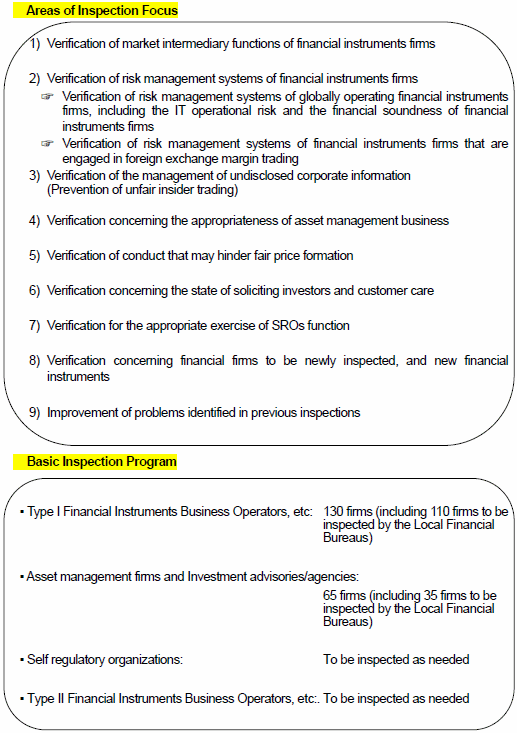 |
|
Senior Vice Minister Tanimoto at the Ordinary General Meeting of the Association for Real Estate Securitization (ARES) (May 21, 2009) |
|
[Topics] [International Affairs] |
[Topics]
On April 24, 2009, the Securities and Exchange Surveillance Commission (SESC)announced the basic inspection policy and Inspection Program for Business Year 2009, which described the Basic Inspection Policy and the number of inspections planned for the year. The outline of the Basic Inspection Policy and Inspection Program for the fiscal year is described below. This time, the period subject to inspection has been changed from a business year basis (from July to June of the following year) to a fiscal year basis (from April to March of the following year).
I. Basic Inspection Policy
(1) Basic concepts
The SESC conducts market surveillance to ensure fairness and transparency of the Japanese markets and to protect investors. Considering the recent expansion of the scope of business operators subject to SESC's inspection and the current global financial risk, it is necessary now, more than ever before, to conduct detailed and rigorous inspections. Under such circumstances, it is important to adopt a ''risk-based, flexible approach,'' which takes into account the size and risk characteristics of each business type and of each operator. In addition, from the perspective of further improving efficiency and effectiveness, it is necessary to conduct inspections that focus more on the status of internal control systems, while ensuring fair trade and the protection of the interests of the public and investors.
Moreover, the inspections need to be performed in a way that responds to market changes in a timely and flexible manner; such an approach should be taken toward the emerging risks in order to prepare for future developments. Bankruptcies of globally operating financial instruments firms could cause considerable confusion in the markets, and possibly systemic risk. In conducting inspections, it is therefore necessary to pay enough attention to the overall status of the management of the risks involved, including the financial soundness of financial instruments firms.
To respond to these considerable changes, it is considered necessary for the SESC to perform more efficient and more effective inspections in pursuit of its basic mission.
''An efficient inspection,'' as mentioned here, indicates that it harnesses and adds to the self-improvement efforts by financial institutions. ''An effective inspection'' indicates that it leads to sustainable improvement in the firms' internal control systems and other outcomes.
More specifically, the SESC's efficient and effective inspection will be achieved on the following terms:
(i) Taking the basic approach of verifying conducts in violation of laws, regulations and market rules; and in consideration of the protection of the interests of the public and investors, focus on verification of appropriateness of the internal control systems, etc., of financial instruments firms, taking into account the size and characteristics of those firms.
(ii) To analyze and identify risk areas in the financial instruments firms to be inspected and adopt a sharper risk-focused approach to inspections.
(iii) To put more emphasis on interactive dialogues with the financial instrument firms with a view to encouraging their voluntary efforts toward developing stronger internal control functions.
(iv) To enhance transparency, in inspection methodology, through the publication of revised inspection manuals.
(2) Areas of focus in inspections
In this fiscal year, the SESC will conduct inspections that focus on the areas listed below.
(i) Verification of market intermediary functions of financial instruments firms
(ii) Verification of risk management systems of financial instruments firms
- Verification of risk management systems of globally operating financial instruments firms, including management systems on the system risk and the financial soundness of financial instruments firms
- Verification of the risk management systems of financial instruments firms that are engaged in foreign exchange margin trading
(iii) Verification of the management of undisclosed corporate information (prevention of unfair insider trading)
(iv) Verification concerning appropriateness of asset management business
(v) Verification of conduct that may hinder fair price formation
(vi) Verification of the appropriate exercise of function of Self-regulatory Organizations(SROs)
(vii) Verification concerning financial firms to be newly inspected and new financial instruments
(viii) Improvement of problems identified in previous inspections
II. Basic Inspection Program
On the basis of this fiscal year's Basic Inspection Program, the SESC will conduct inspections of 130 Type I Financial Instruments Business Operators, etc. (including 110 firms to be inspected by the Local Financial Bureaus), and 65 asset management firms and investment advisories/agencies (including 35 firms to be inspected by the Local Financial Bureaus). In addition, it will perform inspections of SROs and Type II Financial Instruments Business Operators, etc., on an as-needed basis.
* For details, please access Basic Inspection Policy and Inspection Program for Fiscal Year 2009 (April 24, 2009) on the SESC website.
Outline of Basic Inspection Policy and Inspection Program for Business Year 2009



Site Map
- Press Releases & Public RelationsPage list Open
- Press Releases
- Press Conferences
- Official Statements
- FSA Weekly Review & ACCESS FSA
- Speeches
- For Financial Users
- Others
- Archives
- Laws & RegulationsPage list Open
- Name of Laws and Regulations(PDF)

- Recent Changes (Legislation, Ordinances, Guidelines)
- Guidelines
- Financial Instruments and Exchange Act
- Financial Monitoring Policy
- Public Comment
- No-Action Letter System
- Procedures concerning Foreign Account Management Institutions
 Search
Search



